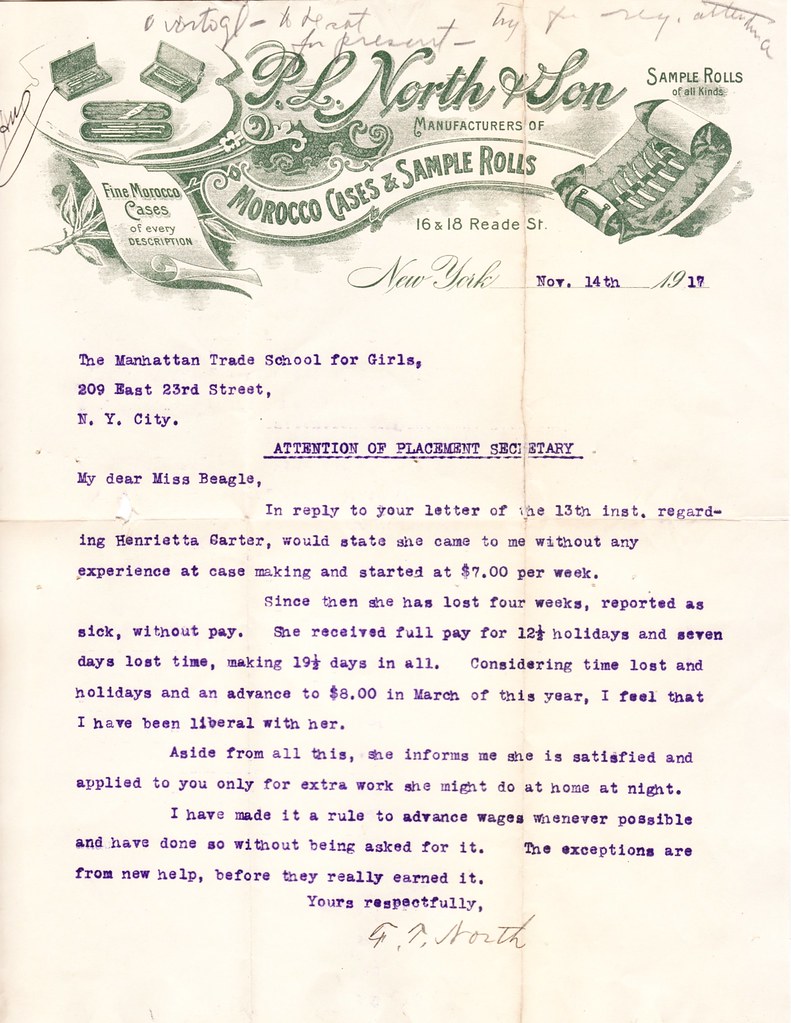
One of the most engaging aspects of the Manhattan Trade School report cards is the way you can reconstruct certain storylines from the data in the files.
Take, for example, the case of the letter you see above, which is in the file of a dressmaking student named Henrietta Carter, who attended Manhattan Trade from 1910 to 1911 (note that her father was a "coaler" -- a nice term). How did that letter come to be written? Here's how we can reconstruct the pieces of the puzzle:
1. Henrietta, like most Manhattan Trade Students, was placed in a series of jobs. If you look in the far-right column of that card, you'll see each of her work assignments was given a number.
2. Those numbers correspond to the numbers in the far-left column of these cards, which have comments from Henrietta (marked with a check in the "Girl" column) and from her employers (marked with an x in the "Employer" column) regarding her work experiences. For example, on May 26, 1911, for employer No. 3, Henrietta reported that she was "Leaving because Miss P. is disagreeable and cross about work." If we go back to the list of employers, we see that employer No. 3 was a Miss Pilcher.
Are you following all of this?
3. Employer No. 21 was L.P. North -- the company whose letterhead is shown at the top of this entry. (As you can see on the letterhead, the company name was actually P.L. North, not L.P. -- a rare slip-up in the Manhattan Trade recordkeeping.) If we look at the comments regarding that job assignment, we see that Henrietta had said, "Want more money -- raised 5 mo. ago." And then it indicates that "H.B" had written to the employer.
4. H.B. was Miss Beagle -- Manhattan Trade's job placement secretary, to whom the letter was addressed. So Miss Beagle, responding to Henrietta's plea for more money, had apparently written to P.L. North, inquiring as to whether Henrietta could receive a raise. And F.T. North (perhaps the "Son" in the company's name?) essentially responded by saying that Henrietta was a bit of a slacker, that he'd already been lenient with her, and that all she really wanted in the first place was some "extra work she might do at home," not a raise.
And there you have it.
Want to go even deeper? Consider this: Henrietta was a dressmaking student (this is indicated at the top-right corner of her main card), so how did she end up working for a company making "Morocco cases and sample rolls"?
The answer lies in some of her work comments. At one point she had reported, "Dr. says I am too nervous for D. ["D" refers to dressmaking.] Would like to combine dressmaking with shipping." Then, 10 days later, "Dr. says must take something entirely different from dressmaking, such as nurse maid." And then, nearly two months later, at the bottom of the card, "Must not do any sewing!"
Fast-forward about four and a half years: Henrietta said, "Would like to try novelty -- too nervous for sewing." The term "novelty" refers to the making of fancy decorative novelty gift boxes. Three weeks later, the school had placed her at P.L. North -- not a novelty box operation, but not a standard garment-sewing job either.
And that's how Henrietta ended up making Morocco cases. And how she eventually complained about not getting a raise. And how her employer said she didn't really deserve one.
Now imagine untangling 395 of these puzzles, and you'll get an idea of what my report card collection is like.

First, I like how Henrietta and her family—Coaler father and all— were living in some of the most expensive real estate in Manhattan: West Village.
ReplyDeleteSecond, do we know how she fared in life? she sounds like a mess!